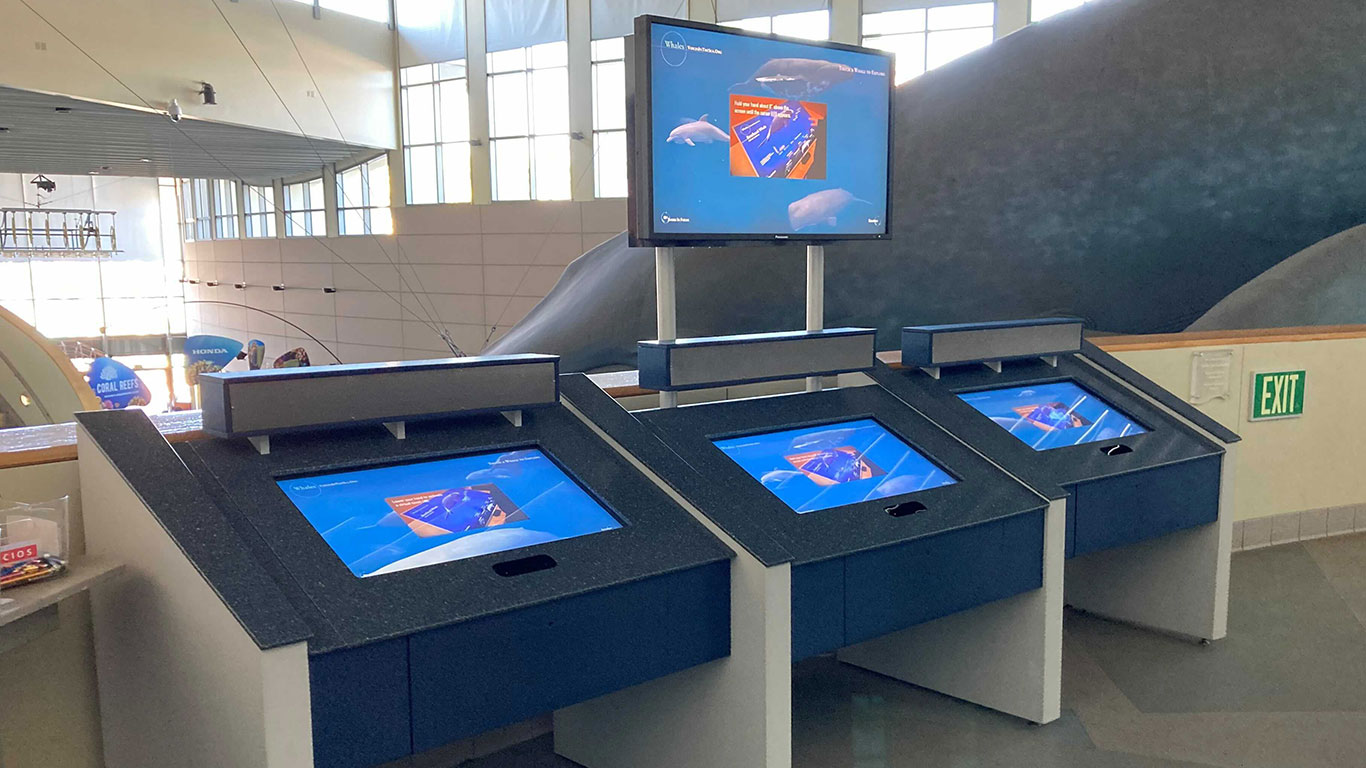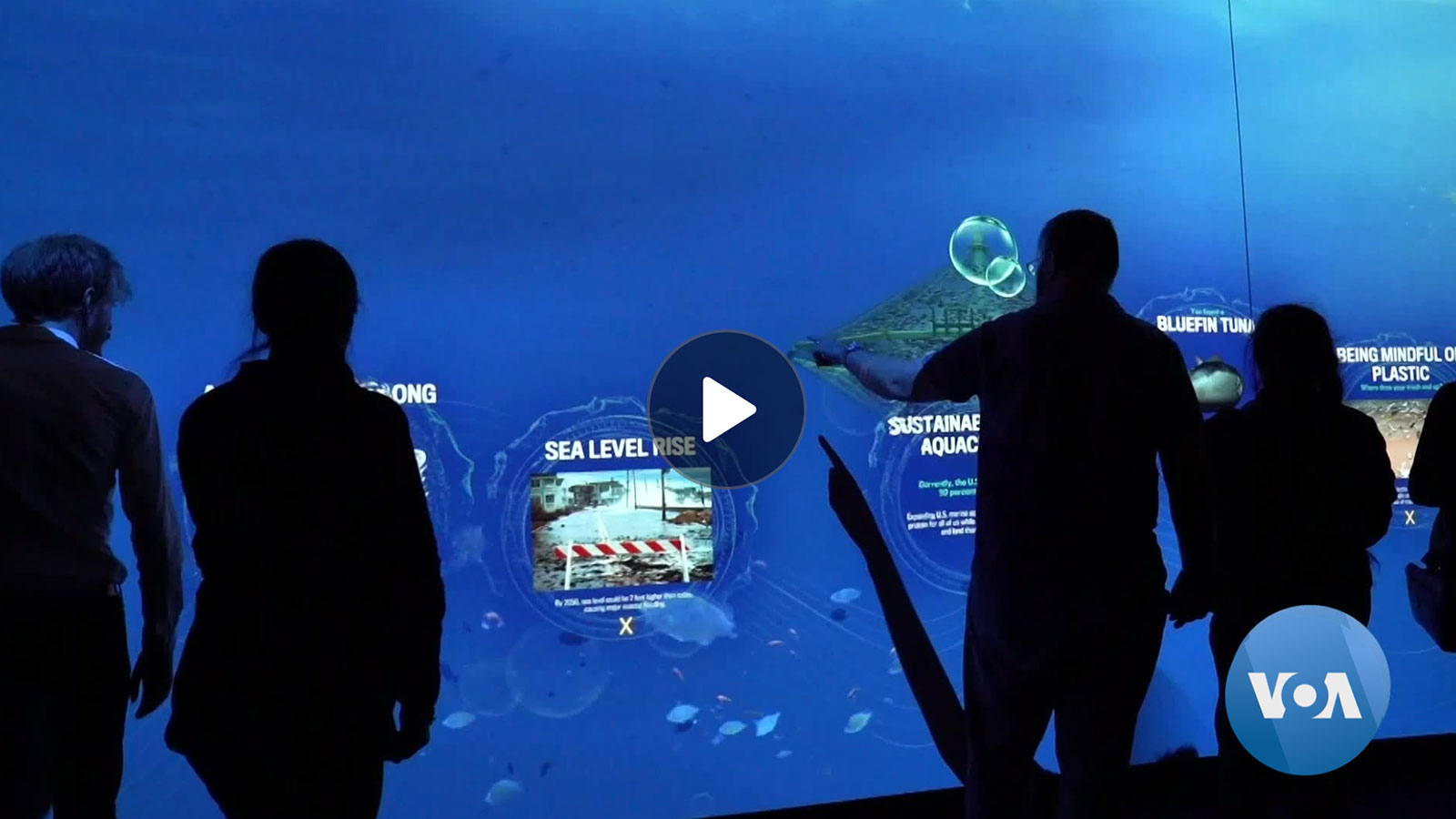
Aquarium of the Pacific: Remaking Visitor Interaction
Posted; November 19, 2020
In the Aquarium of the Pacific in Long Beach, California, Cortina Productions have been using both Ultraleap's hand tracking and haptic technology to reinvent visitor interaction for today's audiences.
In the Honda Pacific Visions Theater, visitors can use assistive technology devices to experience a film like never before – Ultraleap’s “virtual touch” haptic technology lets you feel what’s being shown on screen.
Meanwhile, the 10-year-old Whales: Voices in the Sea exhibit has been retrofitted for touchless interaction using Ultraleap's hand tracking and TouchFree application.
Honda Pacific Visions Theater: Bringing haptics to the big screen
Museums, galleries and aquariums are already using immersive digital experiences to engage visitors. However, these technologies often rely heavily on visual and auditory cues. What about those members of the population who have a sensory disability, such as the loss of sight or hearing?
It’s estimated that around 15% of the world’s population has some form of disability. That’s a large percentage of the public that often has to settle for a sub-par experience as a visitor to an attraction. But when the Aquarium of the Pacific began planning for its new wing, they set out to engage their audience beyond sight and sound alone. They wanted to enrich the experience for all visitors, particularly those with disabilities.

A new wing for the Aquarium of the Pacific
Pacific Visions was planned for more than ten years by the Aquarium of the Pacific before it even made it to the construction stage. All aspects of this new wing were thoroughly thought out, but there was one central theme threaded throughout - accessibility. The Aquarium had set itself a high bar: to go beyond the requirements of the Americans with Disabilities Act.
The Honda Pacific Visions Theater was the keystone project of the new wing. The Aquarium of the Pacific envisioned an immersive theater engaging multiple senses and simulating the sights, smells, and sounds of the ocean. The 300-seat auditorium has a 130ft long curved screen engaging the visitor's peripheral vision and a 30ft diameter projection disk that tilts up from the floor.

At certain points of the film, scents drift over the audience, and the seats shake to enhance shots of a waterfall and a whale diving. The theater is packed full of the standard accessible features including assisted listening devices and portable screens to view captions. Smart glasses worn by viewers can display captioning in English and Spanish. However, to make it a truly multi-sensory presentation for those with disabilities the Aquarium of the Pacific wanted to further engage a sense that is often overlooked – touch.
Enter haptics
Ultraleap worked with Cortina Productions and the Aquarium of the Pacific to add a tactile element to complement the two films currently showing in the theater.
Ultraleap’s "virtual touch" technology uses ultrasound to create the sensation of touch in mid-air. The team created a mobile unit available for check out at the information desk containing a STRATOS Inspire haptic module and a PC that could be rolled next to a designated chair or wheelchair in the theater. The visitor was then able to position their hand over this module and feel different tactile sensations at appropriate points in the film on their hand: a wave splash, the blades of a windmill rotating or foam bubbles bursting.
By adding an element of touch at key points in the film, the Aquarium of the Pacific could provide an augmented experience for visitors with disabilities beyond what was being shown on the screens and heard through the speakers.
The Aquarium of the Pacific's haptic world first
This mobile unit installation is the world’s first haptic enhancement of a film in a museum or aquarium setting. The haptics were easy to install and use, and made a big impact on user experience.

Being able to interpret a film on a tactile level means that the cinema experience is much more engaging and immersive for visitors with disabilities. This was evidenced in a small-scale study conducted by Ultraleap. By using cognitive absorption measurements during the creation of the experience, Ultraleap could assess how deeply involved users were with the experience. The study showed increases in temporal dissociation (the film felt shorter), immersion, enjoyment, and curiosity when haptics were added.
The Aquarium of the Pacific's haptic-enhanced films also allows for a role-reversal of the normal discussion dynamic that follows a family entertainment experience. After engaging with the enhanced films, visitors with disabilities can describe what they felt to other family members and let them know what they were missing out on.
The Pacific Visions wing opened in May 2019 to great audience reviews and reactions. The Long Beach Post called the experience “amazing and, we’ll call it, somewhat thrilling.”
In 2020, the Aquarium of the Pacific and Ultraleap signed a five-year agreement to bring virtual touch experiences to Pacific Visions on a long-term basis.
Whales: Voices in the Sea – Adding touchless interaction
Whales: Voices in the Sea was originally a touchscreen kiosk exhibit. Installed ten years ago, it's still the keystone exhibit at the Aquarium of the Pacific for learning about these marine mammals and their conservation.
However, post-pandemic visitors find touchscreens less appealing than they used to. Cortina Productions turned the exhibit touchless in a matter of days using an Ultraleap hand tracking camera and the TouchFree application.

Visitors can still use touchscreens if they wish, but now also have the option to interact without touching a screen.
TouchFree detects a user’s hand in mid-air and converts it to an on-screen cursor. It's designed to run invisibly on top of existing user interfaces without the need for design modifications. The result was a quick and easy retrofit, bringing the exhibit up to date for today's audiences with minimal effort.
Ready to move beyond?
Explore our blogs, whitepapers and case studies to find out more.





